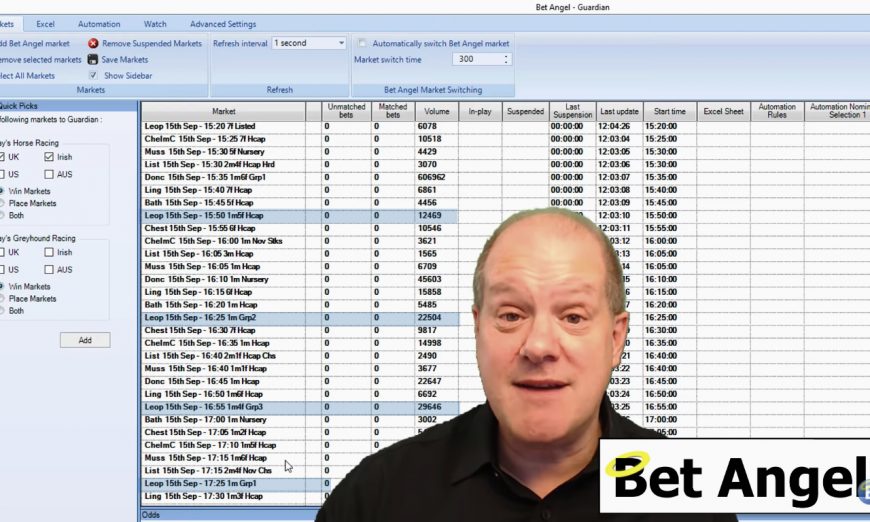I’m predominantly a pre-off Betfair trader on horse racing markets. I cover many sports, but due to the massive number of horse racing markets and their aggregate volume, my favoured Betfair trading market is horse racing.
If you follow me on social media you’ll see that I often tell you what meeting looks good that day or tell you the certain characteristics that are coming out of the markets, anything that I think is of interest!
This is an important part of the trading process when you are looking at pre-race trading. You are examing the betting markets on the Betfair exchange and trying to understand which ones are most likely to throw off the most favourable trading characteristics. Whether you are scalping or swing trading or deploying any type of Betfair trading strategy, knowing where the money is going to be is a key skill.
Therefore, I thought it would be worth showing how I set up and how I assess the day when I begin trading. One September I did a video talking through this and thought I would expand this in this blog post.
Big meetings are the best… or not?
Let’s first start with an example, in this example we’ve got the St Leger running today and Doncaster is the focus meeting of the day. So you would assume that Doncaster would probably be a better meeting to trade, right?
The reason that you could say that is that you know this is where there is a lots of money coming through the market and this tends to produce more favourable characteristics from a trading perspective. However this is not always the case…
Sometimes when you look, for example, at meetings at Cheltenham or some of these really big meetings, there’s so much money that it just swamps the underlying activity on the market. So there is a balance to be had.
In a ‘big’ market price movements will, typically, be small. So the opportunity to lock in a profit would coming from a small price move, you enter and exit the trade fairly quickly. But in lower quality races the move is likely to be much bigger.
One of the skills that I’ve picked up as a trader is I can pretty much turn my hat to anything. If you get a big market with huge liquidity, I’ll adopt a trading style for that. While if we get a really poor, low quality market with low liquidity and higher volatility, then I’ll change my trading style to adapt to that.
Adaptability – a valuable skill
When I first started trading, I’d go into every market and use the same strategy or I would simply sit and wait for the perfect opportunity. But the problem with this it that doesn’t maximise your potential in the market.
One of the ways that I’ve grown to be as big and as capable as I am is being able to flip and flop styles left, right and centre. Which is my advice to the most effective way to trade.
Bet Angel was designed to be Betfair trading software that covers whatever trading style or strategy you wish. So whatever you want to do, we have created a feature to help you.
However, when you’re starting out you’re going to have to start from some base. You practise a strategy, you become good at that and when you’re comfortable with that strategy you can branch out. You’ll probably find it only works in one in five markets or maybe even less depending on what you are trying to do.
But once you have mastered one straategy, this will then encourage you to start looking for other opportunities and different ways of trading these other markets. As I’ve said before, and I’ll say it again:
For every market, there’s a strategy and every strategy, a market. Your role as a trader is to match those two things together.
Therefore, the point I’m just trying to make here is that you can trade every single market, but every market has a correct way of being traded you just may not be able to do it and some will be much harder than others.
How do I make the most out of a market?
For this example I will assess all the best and worse races on the cards, which also happens to include the St Leger. I would be amazed if I don’t make money on the the big race of the day.
It’s just a question of how much, it could be £5 or it could be £500, I’m hoping it’s going to be five hundred! But you can’t specifically tell until you reach that market. However, you can look at the markets and make some broad judgement on what you think is going to happen within the markets and where the most of the betting activity will be over the course of the day.
Let’s go step my step how I would approach this market. This example is quite interesting because of the mixture of meetings that we’ve got going on in this particular day.
So what I do before the session starts is to follow my well-practised daily routine. I fire up Bet Angel put all the markets into Guardian and have a quick assessment on what’s going on within those markets.
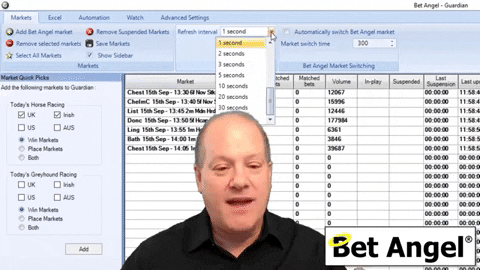
In this example, we are going to look at the UK and the Irish racing. I’ve added the markets to guardian and you can see in the image above, that at the moment we’ve got it on a one second refresh. So it will just gently populate the markets. To speed this up it is simple, all you need to do is change the refresh rate and you will see all of the markets are active and presented to you.
So if we go down this list, we can see we’ve got Chester, Chelmsford, Listowel, Doncaster… there’s a lot of races on today! That’s the first assessment you can make, you can see that Chester goes off at 13:30, 10 minutes later we’ve got Chelmsford, then five minutes we’ve got Listowel, then five minutes after that we’ve got Doncaster than five minutes after that we got Lingfield etc.
It looks like it’s going to be a crazy day with lots of races happening left, right and centre!
When I look at this card, I’m thinking, ‘well Listowel is in Ireland, it’s over jumps were at the tail end of the summer’ (this example is from September), so the problem is that it’s going to get no focus at all, being in Ireland with jumps it contains characteristics that don’t look particularly suitable. I’d be surprised if we get any significant volume at that particular meeting.

Trading the big race of the day
If we look at the volume at Listowel, you can see in the image above that it’s around 12,500. Then if we look at the volume of the Doncaster race you can see here there’s 170, 000 vs 12,500 at Listowel.
So which one would you choose?!
Would you go for 12,500 at the Irish jumps meeting or would you go for the St ledger meeting on a Saturday? I think that’s fairly obvious which one you choose to go for! Because of this I will probably skip Listowel today, especially as it’s going off just before Doncaster which is which is our obvious focus today.
Let’s also look at the image below at the volume at other races, looking a Lingfield which is after these races and you can see that’s pretty low, Bath after Lingfield is even lower. You can see that this pattern of behaviour continues during the day.
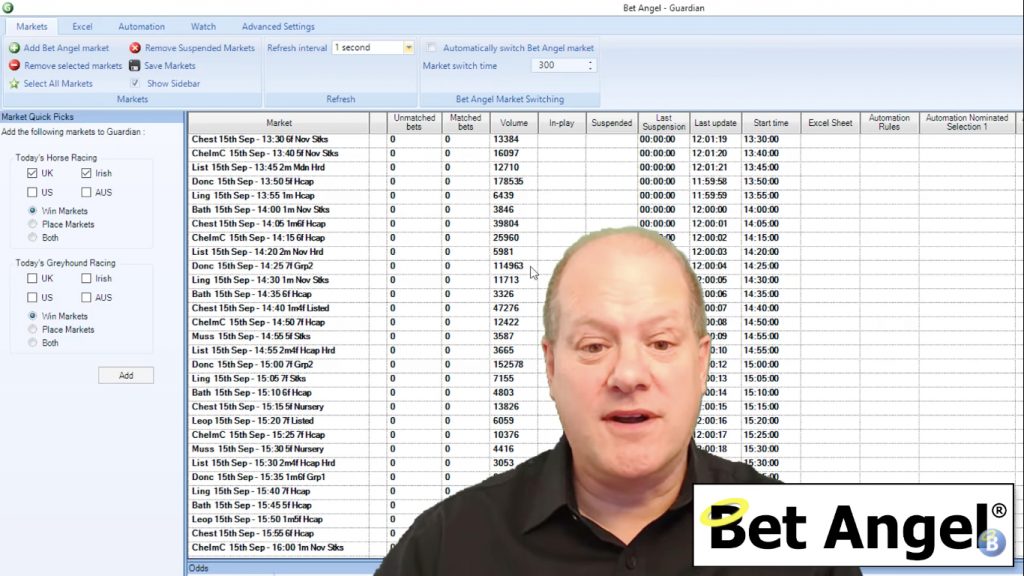
You can see we’ve got Chester, that looks pretty good, as well as quite a bit of activity at Chelmsford already. You can then see it dips when we go to the Irish jumps and then there’s a group two Doncaster so there’s lots of liquidity there.
So you can see there’s races about every five minutes today, so realistically you’ll probably get pretty tired if you try and trade every single five minutes.
You need to also remember that some of the races will go off late and they’ll clash with other races which will take and that will take away some of the volume. However, you can see there’s a pattern beginning to develop there.

The big race of the day is the St Leger, which we can highlighted above. You see that £600,000 has been matched in that market already, which is huge!
So as we get closer and closer to the St Leger I will turn my attention to that particular race and I will probably do that about half an hour before the race is due to get underway.
Now, most of the liquidity won’t arrive in that race until we get a little bit closer to the start, so because of that I will carefully monitor it and I may actively start putting trades in around 15 to 20 minutes out, but then I will trade it quite aggressively as the volume begins to flow in.
Looking out for clashes
Let’s look at the other races around this time, here we’ve got Musselburgh in front of Listowel, which goes off at the same time as Musselburgh annoyingly! But even more annoyingly, St Ledger goes off five minutes later, what is the racing doing?!
It’s the oldest classic that we have, why don’t they give it a 50 or 20 minute gap when scheduling so that everybody can watch it, get excited about it, place their bets, trade it, do whatever they want to and enjoy the race, but no, let’s just chuck it in the middle of everything else, sorry rant over!
This is unfortunately a hurdle you have to face when deciding what market is best, it is almost inevitable that races are going to clash with the St Leger. Musselburgh may go off late, at Listowel, they mostly won’t care about the St Leger.
This is a shame within racing that they can’t give a better scheduling and would much prefer it if there was a nice clean gap just before it. This is why Cheltenham trades really well because you get lovely clean gaps between all of the races of that time of the year and you don’t necessarily get that at other times of the year.
Anyhow, as we head through the card you can see that Musselburgh is going on at the same time as the Irish race and this reinforces that today we should just forget Listowel as it is not worth looking at.
To help keep focused on what I want to trade each day, I find the races that do not appear as attractive and remove it from Guardian, like I will with Listowel in today’s example.
Spotting great markets that aren’t always obvious
So we have explored the obvious favourite of the today’s example card, however there is always opportunity to find other great markets throughout the card.
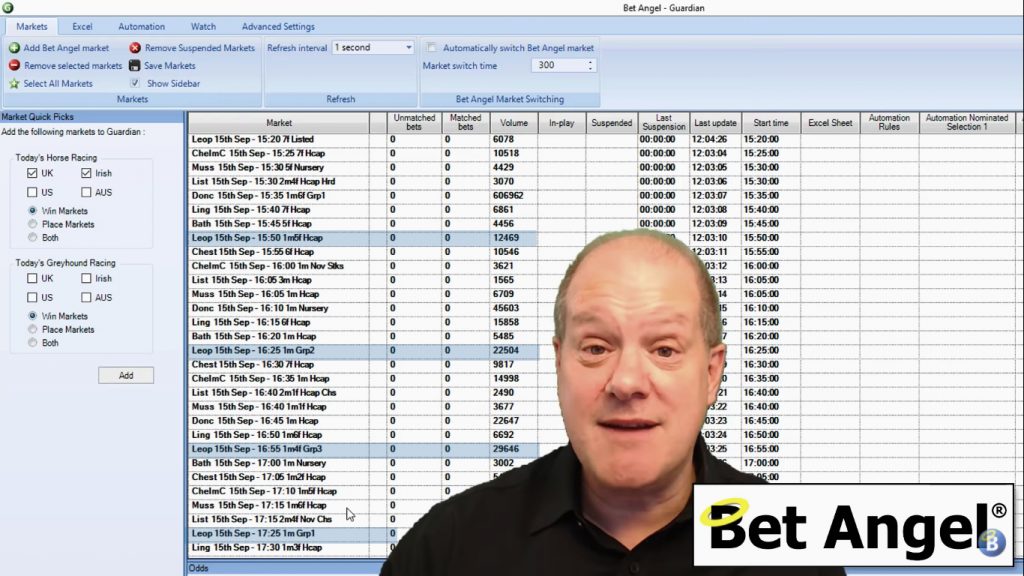
As we move through the day we can see that Leopardstown coming into the mix. If we look down at Leopardstown, you can see we’ve got a group two race, group three race and then we’ve put a group one at 17:25 and there is a 10 minute gap there between Listowel and Musselburgh if they go off on time.
So as we’re looking through this entire card you can see there are further opportunities arising when we look at the group races.
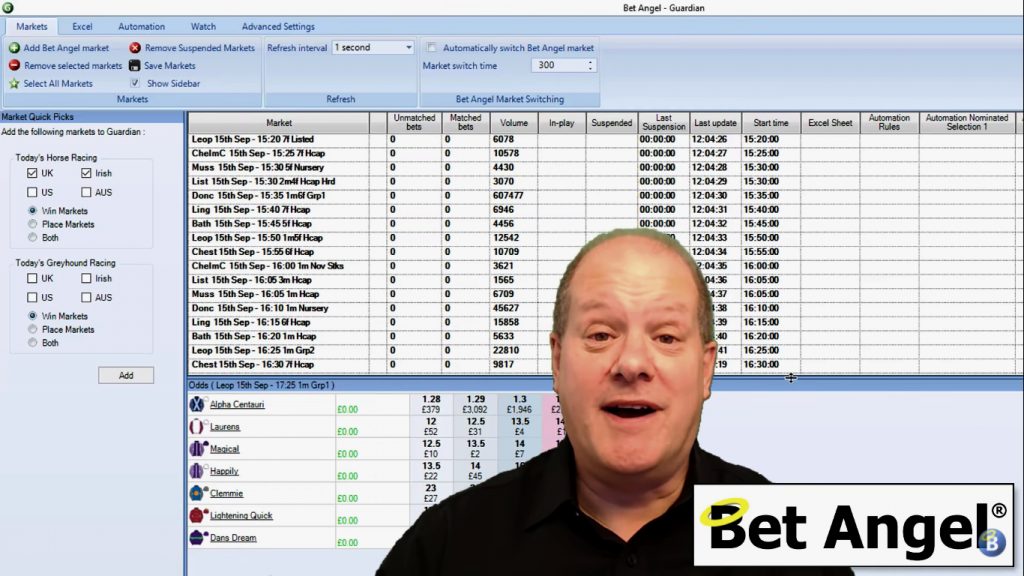
You can you see in the image above that there is a very short price for this market and I know how I’m going to trade this already.
By taking one look at this market, I know that it’s going to have my focus when I arrive at this market a bit later and I already know what I’m going do on this race. At the moment it is too early to do anything at this moment in time.
However, with just one glance at that market it will tell me exactly what I need to know to help me pin point how I’m likely to trade this market closer to the race start. For now I just need to sit there and wait for the characteristics to develop and then jump on the trade when I’m ready.
But you can see that you can gain a lot of information from looking at Guardian in this particular way.
My golden tip for you…
If you want to figure out where the strongest meetings are there is a neat trick you can do on Bet Angel to resort your card screen.
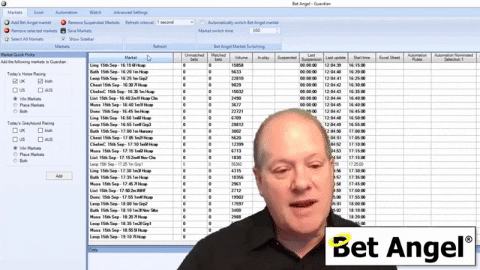
If you just change the way you view your Guardian screen by clicking on the header for markets then this will sort it by market type like shown above.
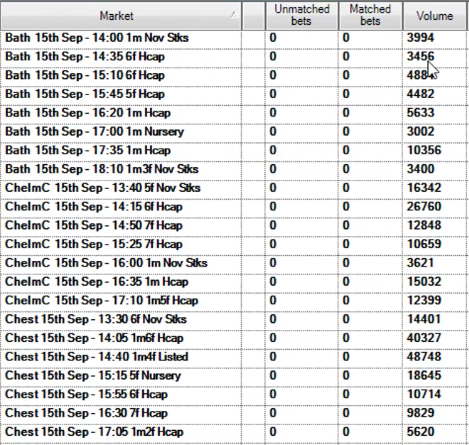
If we look at Bath in today’s example above, you can see the volume at the moment is three, four, five, three thousand and there’s a bit of money on the 17:35 race.
While in Chelmsford you can see above that the amount of money is being matched in the 10s and 20s. So it is a clear comparison that Chelmsford market is better than Bath.
Just by looking at the three markets above you can see decent amounts of money at Chester. By organising your card by grouping the races together by location it allows you to assess the volume of activity.
At the bottom of my card in this example we have Listowel which once again reinforce what I said earlier and so I would on a usual day not bother trading these types of markets. This allows for a great overview of the volume in each race location.
Two key ways to help find the best markets
- By having your Guardian screen sorted by market it will give you a good indication as to where the the betting focus is. Decent betting heats tend to produce decent trading heats.
- By having your Guardian screen sorted by start time, which is how we first approached it at the start of the blog, you can see that you can get an idea about the flow of the day and where the feature races are, where the biggest amount of money’s been matched and what impact that has on the trading market over the course of the day.
I’ll show you one last little tip here as well…
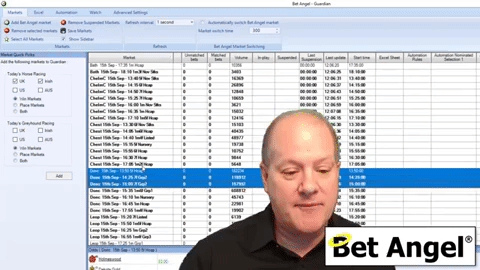
If I go in and mark these Doncaster races and then sort by start time (shown above.) You see that you get a highlighted bar basically telling you where those feature races are, this can then help you start looking at these race in the run up compared to other races. Once again giving you an idea of where to look.
This is the sort of exercise that I go through every day, every couple of hours or so before the racing starts. I’ll go through the cards, make an assessment on where the big races are with the ones that I want to trade and I’ll make a little note. Here’s some key features that I look for:
- Markets that stand out to me that I want to trade
- Characteristics that I’ve seen before
- What I’ve seen from last year
- How I expect the market to behave
After I made a little note of the things mentioned above I’ll then come and sit down at my desk for 15, 20 minutes before the first race and get underway on the day. I keep my eye on the racing all day and I won’t stop until the last race has finished!
Summary
Analysing the markets you want to trade will help you indentify key trading markets of the day and how they line up. When you analyse markets in this way you will quickly begin to understand the ‘shape’ of the trading day ahead of you.
As well as targeting individual meetings and races you may want to trade or avoid. You can quickly check to see if there are interesting markets that you recognise but also if there is an unusual level of interest in specific markets. Allowing you to investigate them further.
So if you’re interested in trying to understand what’s coming up in front of you, the markets and how they could be interesting, then this is what I suggest.
Have a plan established before the day begins. I do this setup every day before every trading session and I suggest that you should do the same as this is a great way of finding the best markets of the day.

